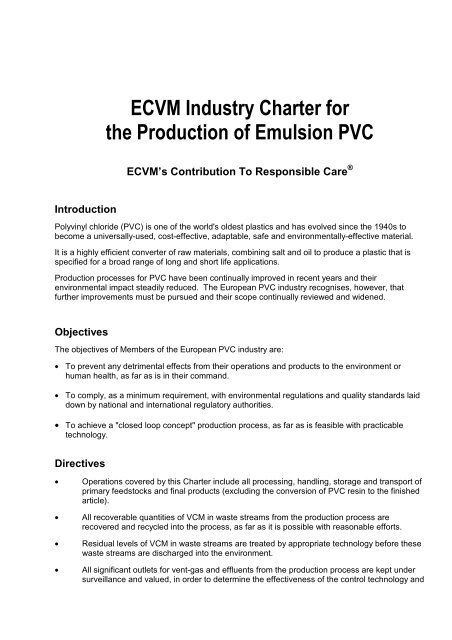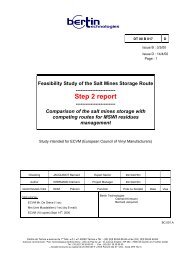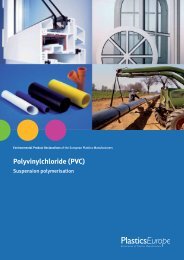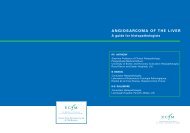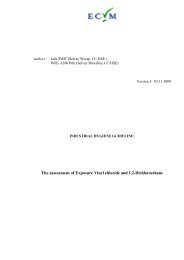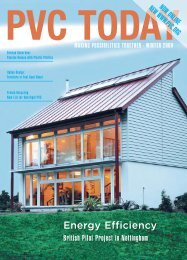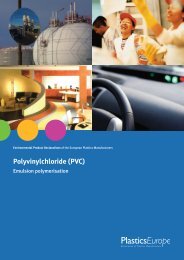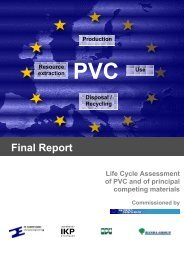ECVM Industry Charter for the Production of Emulsion PVC
ECVM Industry Charter for the Production of Emulsion PVC
ECVM Industry Charter for the Production of Emulsion PVC
Create successful ePaper yourself
Turn your PDF publications into a flip-book with our unique Google optimized e-Paper software.
<strong>ECVM</strong> <strong>Industry</strong> <strong>Charter</strong> <strong>for</strong><br />
<strong>the</strong> <strong>Production</strong> <strong>of</strong> <strong>Emulsion</strong> <strong>PVC</strong><br />
<strong>ECVM</strong>’s Contribution To Responsible Care ®<br />
Introduction<br />
Polyvinyl chloride (<strong>PVC</strong>) is one <strong>of</strong> <strong>the</strong> world's oldest plastics and has evolved since <strong>the</strong> 1940s to<br />
become a universally-used, cost-effective, adaptable, safe and environmentally-effective material.<br />
It is a highly efficient converter <strong>of</strong> raw materials, combining salt and oil to produce a plastic that is<br />
specified <strong>for</strong> a broad range <strong>of</strong> long and short life applications.<br />
<strong>Production</strong> processes <strong>for</strong> <strong>PVC</strong> have been continually improved in recent years and <strong>the</strong>ir<br />
environmental impact steadily reduced. The European <strong>PVC</strong> industry recognises, however, that<br />
fur<strong>the</strong>r improvements must be pursued and <strong>the</strong>ir scope continually reviewed and widened.<br />
Objectives<br />
The objectives <strong>of</strong> Members <strong>of</strong> <strong>the</strong> European <strong>PVC</strong> industry are:<br />
• To prevent any detrimental effects from <strong>the</strong>ir operations and products to <strong>the</strong> environment or<br />
human health, as far as is in <strong>the</strong>ir command.<br />
• To comply, as a minimum requirement, with environmental regulations and quality standards laid<br />
down by national and international regulatory authorities.<br />
• To achieve a "closed loop concept" production process, as far as is feasible with practicable<br />
technology.<br />
Directives<br />
• Operations covered by this <strong>Charter</strong> include all processing, handling, storage and transport <strong>of</strong><br />
primary feedstocks and final products (excluding <strong>the</strong> conversion <strong>of</strong> <strong>PVC</strong> resin to <strong>the</strong> finished<br />
article).<br />
• All recoverable quantities <strong>of</strong> VCM in waste streams from <strong>the</strong> production process are<br />
recovered and recycled into <strong>the</strong> process, as far as it is possible with reasonable ef<strong>for</strong>ts.<br />
• Residual levels <strong>of</strong> VCM in waste streams are treated by appropriate technology be<strong>for</strong>e <strong>the</strong>se<br />
waste streams are discharged into <strong>the</strong> environment.<br />
• All significant outlets <strong>for</strong> vent-gas and effluents from <strong>the</strong> production process are kept under<br />
surveillance and valued, in order to determine <strong>the</strong> effectiveness <strong>of</strong> <strong>the</strong> control technology and
to measure <strong>the</strong> final discharge <strong>of</strong> potential contaminants into <strong>the</strong> environment.<br />
• Fugitive emissions are reduced by installing leak-safe technology and by frequent<br />
inspections to check <strong>the</strong> integrity <strong>of</strong> all relevant sealings. This can be supported by installing<br />
fixed monitoring systems <strong>for</strong> measuring VCM concentrations.<br />
• Residual levels <strong>of</strong> VCM in <strong>the</strong> final <strong>PVC</strong> product will not exceed <strong>the</strong> amounts agreed.<br />
The Members <strong>of</strong> <strong>the</strong> European Council <strong>of</strong> Vinyl Manufacturers<br />
Accept<br />
• That all production, manufacturing and disposal processes <strong>of</strong> modern industrialised society<br />
have an impact on <strong>the</strong> environment. <strong>PVC</strong> is no exception.<br />
• That <strong>the</strong> European <strong>PVC</strong> industry's stakeholders have <strong>the</strong> right to expect that that impact is<br />
determined and, if necessary, reduced in order to meet environmental quality objectives<br />
within <strong>the</strong> scope <strong>of</strong> Best Available Techniques (BAT) experience and resources.<br />
• That, as a material whose production, use and disposal continually evolves, stakeholders<br />
have <strong>the</strong> right to expect <strong>the</strong> industry to be vigilant and <strong>for</strong>ward-looking in ensuring that<br />
appropriate objectives are set and met.<br />
• That all <strong>ECVM</strong> Members will share <strong>the</strong>ir environmental control `know how' by bilateral<br />
agreement.<br />
Commit<br />
• To agree priorities <strong>for</strong> environmental control and improvement to:<br />
- Reduce emissions and o<strong>the</strong>r environmental pollutants by introduction <strong>of</strong> voluntary,<br />
controlled systems <strong>of</strong> target-setting, measurement, and operational improvements,<br />
setting short, medium and long-term targets that consistently maintain improvements in<br />
environmental per<strong>for</strong>mance.<br />
- Invest in research to pursue future improvements in line with <strong>the</strong> agreed priorities.<br />
- Work in associated industry groups, where appropriate, to improve understanding <strong>of</strong><br />
shared environmental concern, and to improve processes and technologies to minimise<br />
environmental impacts, such as improved recycling and incineration techniques.<br />
- Annually review priority standard targets and future areas <strong>for</strong> action.<br />
• To ensure that <strong>the</strong> environmental control per<strong>for</strong>mance, if not made by <strong>the</strong> national<br />
authorities, will be open to review by an independent third party (eg: an accredited<br />
environmental verifier according to <strong>the</strong> rules <strong>of</strong> <strong>the</strong> European Union Eco Audit Scheme)<br />
subject to specification and agreement between <strong>ECVM</strong> and member companies.<br />
• To agree that, whereas some companies already comply with <strong>the</strong> criteria <strong>of</strong> this <strong>Charter</strong>,<br />
those that do not yet comply will use <strong>the</strong>ir best ef<strong>for</strong>ts to do so by end 2003.
Act<br />
• To ensure that any <strong>ECVM</strong> Member which consistently fails to meet agreed industry targets <strong>of</strong><br />
environmental improvement over clearly-defined periods <strong>of</strong> time, is called to account.<br />
• To work with o<strong>the</strong>r industry bodies, Non-Governmental Organisations (NGOs), stakeholder<br />
groups and o<strong>the</strong>r interested organisations to agree common working agendas to improve<br />
environmental per<strong>for</strong>mance as research, science and technology increases understanding <strong>of</strong><br />
<strong>the</strong> relationship between <strong>the</strong> <strong>PVC</strong> industry's activities and <strong>the</strong> needs and concerns <strong>of</strong> its<br />
stakeholder communities.
Annex to <strong>Industry</strong> <strong>Charter</strong> <strong>for</strong> <strong>Production</strong> <strong>of</strong> E - <strong>PVC</strong><br />
(<strong>Emulsion</strong> Process)<br />
(Reference: <strong>ECVM</strong> Best Available Techniques <strong>for</strong> <strong>Emulsion</strong> <strong>PVC</strong>)<br />
ENVIRONMENTAL STANDARDS FOR <strong>PVC</strong> PRODUCTION (EMULSION PROCESS)<br />
Total VCM-emission in <strong>the</strong> air : < 1000 g/ton <strong>of</strong> E-<strong>PVC</strong><br />
VCM-emission in aqueous effluents<br />
For stand alone <strong>Emulsion</strong> <strong>PVC</strong> plant : < 1 g/m3 <strong>of</strong> effluent<br />
and < 10 g/t <strong>of</strong> E-<strong>PVC</strong><br />
In case <strong>of</strong> common treatment with Suspension <strong>PVC</strong> units :<br />
< 1 g/m3 <strong>of</strong> effluent<br />
or < 5 g/t <strong>of</strong> E+ S-<strong>PVC</strong><br />
VCM-concentration in final regular product : < 1 g/ton <strong>of</strong> E-<strong>PVC</strong><br />
November 1998<br />
Cha006


